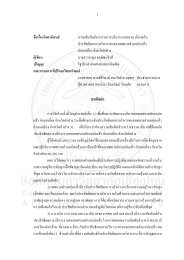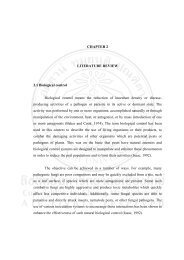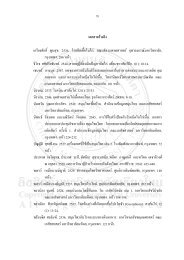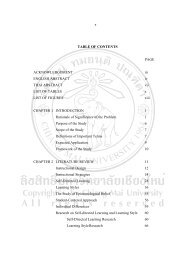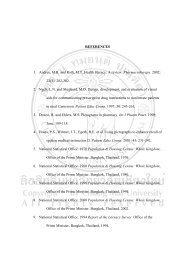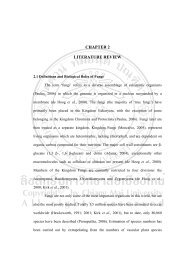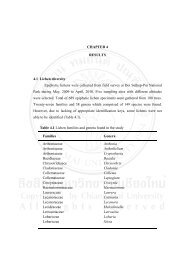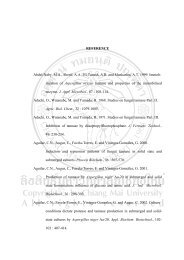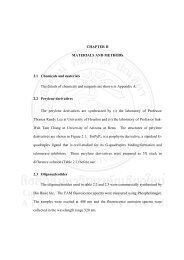prevalence and molecular characteristics of vibrio species in pre ...
prevalence and molecular characteristics of vibrio species in pre ...
prevalence and molecular characteristics of vibrio species in pre ...
You also want an ePaper? Increase the reach of your titles
YUMPU automatically turns print PDFs into web optimized ePapers that Google loves.
27<br />
Vibrio spp. display similar biochemical <strong>characteristics</strong> <strong>and</strong> it limits the proper<br />
identification <strong>and</strong> characterization <strong>of</strong> Vibrio spp. (Tamrakar et al., 2006). Scientists<br />
have developed PCR based techniques for the detection <strong>of</strong> toxigenic stra<strong>in</strong>s based on<br />
the cholera tox<strong>in</strong> (ctx) gene, <strong>and</strong> the tox<strong>in</strong> coregulated (tcpA) gene (Keasler <strong>and</strong> Hall,<br />
1993, Rivera et al., 2003).<br />
V. parahaemolyticus has been recognized as major pathogenic agent <strong>of</strong><br />
gastroenteritis associated with the consumption <strong>of</strong> seafood (Nishibuchi <strong>and</strong> Kaper,<br />
1995). But not all V. parahaemolyticus stra<strong>in</strong>s are carry<strong>in</strong>g the virulence capacity<br />
(Raghunath et al., 2008). Cl<strong>in</strong>ical stra<strong>in</strong>s are categorized <strong>in</strong>to two groups accord<strong>in</strong>g to<br />
their ability <strong>of</strong> haemolys<strong>in</strong>g Wagatsuma blood agar. This is named as Kanagawa<br />
phenomenon (KP). Most <strong>of</strong> the cl<strong>in</strong>ical stra<strong>in</strong>s <strong>of</strong> V. parahaemolyticus are haemolytic<br />
(KP + ). This haemolys<strong>in</strong> was identified as thermo stable direct haemolys<strong>in</strong> (TDH),<br />
because it was not <strong>in</strong>activated by heat<strong>in</strong>g at 100°C for 10 m<strong>in</strong>. Kanagawa<br />
phenomenon negative stra<strong>in</strong>s were isolated <strong>and</strong> named as TDH-related haemolys<strong>in</strong><br />
(TRH) <strong>and</strong> its activity is lost when heated at 60°C or higher temperature for 10 m<strong>in</strong>.<br />
(Honda <strong>and</strong> Iida, 1993). Cl<strong>in</strong>ical stra<strong>in</strong>s <strong>of</strong> V. parahaemolyticus most <strong>of</strong>ten produce<br />
TDH or TRH haemolys<strong>in</strong> <strong>and</strong> carry the gene for tdh <strong>and</strong> trh respectively (Nishibuchi<br />
<strong>and</strong> Kaper, 1995, Raghunath et al., 2008). Both TDH <strong>and</strong> TRH stra<strong>in</strong>s have similar<br />
biological, immunological <strong>and</strong> physiochemical <strong>characteristics</strong> <strong>and</strong> they are composed<br />
<strong>of</strong> 165 am<strong>in</strong>o acids <strong>and</strong> their am<strong>in</strong>o acid sequence homology is about 67% (Honda<br />
<strong>and</strong> Iida, 1993). These data suggested that trh <strong>and</strong> tdh genes probably evolved from a<br />
common ancestor. Researchers identified the tdh gene <strong>in</strong> some stra<strong>in</strong>s <strong>of</strong> V. mimicus,<br />
V. cholerae non-O1 stra<strong>in</strong>s from the mar<strong>in</strong>e environment <strong>and</strong> occasionally from<br />
diarrhoea samples while all the stra<strong>in</strong>s <strong>of</strong> V. hollisae were positive for tdh gene<br />
(Honda <strong>and</strong> Iida, 1993, Nishibuchi <strong>and</strong> Kaper, 1995).<br />
Identification <strong>of</strong> virulent stra<strong>in</strong>s <strong>of</strong> V. parahaemolyticus has been done with<br />
the conventional methods, such as detection <strong>of</strong> haemolys<strong>in</strong> <strong>in</strong> Wagatsuma agar<br />
conta<strong>in</strong><strong>in</strong>g washed human or rabbit erythrocytes, immunological methods (reverse<br />
passive haemagglut<strong>in</strong>ation, ELISA) (Honda <strong>and</strong> Iida, 1993). But for the detection <strong>of</strong><br />
TRH there are no available commercial methods. Therefore identification <strong>of</strong> virulence




